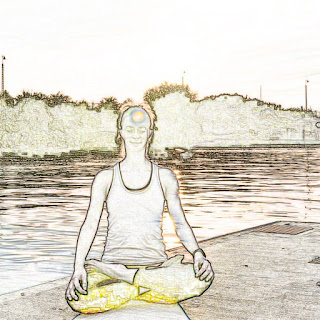Padmasana:
It is called Padmasana because it looks like a bloomy lotus seen in the Yoga practice. As the potato in vegetables makes all the work is done by all the workers, as well as the application of yoga exercises, due to the popularity due to its popularity, many myths can be observed in this mystical Padmaon study.
Padmasana is basically three types: free-Padmasana, closed-Padmasana and raised Padma Sadan.
Mukta-Padmasana or Siddhasana:
 |
| Mukta-Padmasana |
Method:
Sit straight on the head and spread the legs. Now break the left leg from the knee and place it on the right thigh and the left foot as well on the left thigh. Put your two hands on the cheetah or chit or put it on both sides of the palm (the siddhasan is also called siddhasana). Or put on the chest in the salute gesture. Now touch the nasal nose and the tip of the tongue to the end of the grip. Stay in that condition as long as possible. There is no harm if there is much time in the Padma. Breathing must be normal.
Change the legs, ie, firstly break the right leg from the knee to the left, and keep the left foot on the right thigh as well as remain in this condition as long as you have practiced. Then gradually take the rest of your legs and take rest.
Advantages:
According to Yoga, all diseases are removed from the seat. Increases the performance of the heart and lungs. As a result, asthma cannot be a disease, but it can be cured sooner. Keep the spine straight and straight. Enhances thinking, memory, and willpower and brings the mind to concentration. Feet muscles and nerves keep fresh and active. The body can not attack the artery or cystic.
(2) Baddha-Padmasana
Method:
First, sit down and sit in the Padma. Now turn the right arm backward and move it along the right leg's thumb and the left hand and the left hand put the old finger of the left foot. The breathing will be normal. In this way, change the hands and feet from this seat for a little while, and if necessary, take rest as you need.
 |
| Baddha-Padmasana |
Advantages:
All the qualities of Padmaasan are present in this seat. This results in quick results. The seat also eliminates the structural defect of the shoulder and chest cage.
(3) grown up Utthita Padmasana
Method:
Sit down in the free-lunar month. Now place two hands on both sides of the pouch. Now take your breath and hold the body slightly above the chest of your hands and release it. Keep breathing in normal condition and keep it in 20-25 seconds. Then leave the body and leave the body and sit in the Padma Sadan. Change the zodiac to rest and change it again. Take the rest of your life, if necessary.
 |
| grown up Utthita Padmasana |
Advantages:
There are almost all the qualities of the free-lot of Padma. In addition, increased abdominal fat reduces fat, strengthens the hands and shoulders muscles and brings great energy to the hand.
Seat-Diversity:
Apart from this fundamental practice of Padmasana, there is a new process to see Padmasana in practice. Among these created seats, half-Padmasana, Upper-Padmasana, half-closed-Padmasana are one.






कोई टिप्पणी नहीं:
एक टिप्पणी भेजें